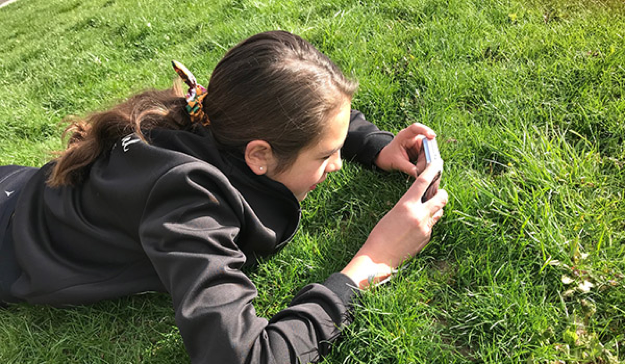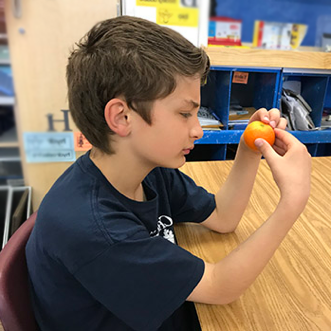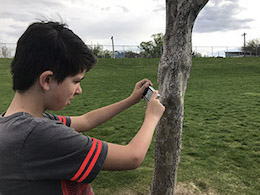SUBJECTS
GRADE
Show Results
Media and Observation

Lesson Summary
- Learn how to observe the ordinary and turn it into the extraordinary.
- Create photo essays as a group.
- Share media messages through stories and photographs.
Lesson Plan and Procedure
Lesson Key Facts
- Grade(s): 3, 4, 5, 6
- Subject(s): English Language Arts, Media Arts, Visual Arts
- Duration of lesson: Two sessions, 45 minutes each
- Author(s): Amy Peterson Jensen, PHD; Erika Hill
Invitation to Learn
Bring a small sack of oranges. Have the students feel them, smell them, and then write a detailed description of them. Have them share the free-write with another student.

Instruction and Creation
Teacher: This lesson is about "observing the ordinary." Think what this might mean as you watch the following clip. Pay particular attention to both the story and the way that the story is told.
Share A. Todd Smith's short film (three minutes) with the class: http://studentfilms.byu.edu/?p=57.
Ask the following questions after viewing the clip:
- What is the story here?
- What is ordinary?
- What is extraordinary?
- How is this story told?
Teacher: We are surrounded by ordinary things, but we often find that if we take time to think about and document those ordinary things, they become beautiful or extraordinary. The person who made this film knows this, and he uses his artistic talents to recreate ordinary settings.
Share a few examples of series photography that sends a message or shares a story of ordinary things. Several examples can be found on the following websites. Preview the sites before you show them to your students.
- https://photographywithmisswilson.weebly.com/what-is-a-series.html
- https://www.canva.com/learn/7-photo-series-inspire-can-make/
- https://iphonephotographyschool.com/photo-series/
- https://mymodernmet.com/adrian-klein-pnw-landscape-photography/
If time permits, share Flotsam by David Wisner, and emphasize the images of the ordinary and the story that evolves. Here is a link to an online version, although a hard copy is recommended so that students can refer to it during this lesson: https://www.youtube.com/watch?v=3MTKWnxzqvM.
Divide students into groups. The size of the group will depend on how many cameras are available. Distribute Polaroid or digital cameras to groups.
Teacher: As a group, you have 20 minutes to explore the school and practice observing the ordinary; each student in the group may take one picture of something ordinary that he or she finds beautiful. Each group will need to choose their own theme or one of the following themes to focus on: specific parts of nature such as clouds or trees; structures such as chairs, shoes, or doors; or community spaces, lines, signs, micro views, etc.


Give students time to explore and take pictures. When the students return, keep them in their groups and have them look at their pictures.
Teacher: As groups, combine and construct a short story from some or all of the images of ordinary things you took. These stories may be factual or fictional, but they must demonstrate your appreciation of the ordinary. You will share your stories with the class.
Give students time to work on their stories. If digital cameras were used, some way of projecting the pictures will be necessary. This is most easily accomplished with a laptop and a projector, but the pictures do take a bit of time to download from camera to computer, so be sure to factor this in; if necessary, have the groups that took the photo essays write the story that they feel their images tell while you download the pictures.
Share and Discuss
After the stories and images have been created, give each group time to share theirs. Discuss the method of storytelling within each story. Also, explore the function that images have in shaping our stories. Why might this be important as we seek to understand media?
Ask students to think about whether the media they consume concentrates on the ordinary or the extraordinary.
Extensions

- Have students watch for media that concentrates on the ordinary and then write a short journal entry about it.
- Have students write individual stories that observe the ordinary.
- Have the students observe an ordinary object with their parents and talk about what makes that object extraordinary. If possible, ask the students to take a photograph, draw a picture, or write a brief paragraph about the object that they observed. They could report on the experience in class.
Learning Objectives
- Organize and document ordinary parts of the world through storytelling.
- Practice the use of transitional words and phrases.
- Collaborate and participate in creating a theme for creative photo taking.
- Take pictures that demonstrate careful observation.
- Participate in active viewing and creation of photo essays.
Utah State Board of Education Standards
This lesson can be used to meet standards in many grades and subject areas. We will highlight one grade’s standards to give an example of application.
Grade 4 English Language Arts
Standard 4.W.3: Write narrative pieces to develop real or imagined experiences or events using effective technique, descriptive details, clear event sequences, and provide a resolution.
Orient the reader by establishing a situation and introducing a narrator and/or characters; organize an event sequence that unfolds naturally.
- Use a variety of transitional words and phrases to manage the sequence of events.
Grade 4 Visual Arts
Standard 4.V.CR.1: Brainstorm multiple approaches to a creative art or design problem.
Standard 4.V.CR.2: Collaboratively set goals and create an artwork that is meaningful and shows the intent of the makers.
Grade K-5 Elementary Library Media
Strand 13: Produce and present
Standard 1: Identify messages for presentation, using a multi-step process, by determining intent, content, audience, and length.
Standard 2: Develop and apply criteria for quality media productions.
Standard 3: Create, present, and evaluate the final product.
Equipment and Materials Needed
- A sack of oranges
- Short film Ode to an Orange: http://studentfilms.byu.edu/?p=57
- Series photography PowerPoint presentation
- Polaroid or digital cameras
- Wiesner, David. Flotsam. New York: Clarion Books, 2005.
Additional Resources
- Seeing and Writing 2 (Donald McQuade and Christine McQuade eds.), published by Bedford/St. Martin's in 2003
- "Flotsam by David Wiesner": (Mr. Baker's Bookshelf) https://www.youtube.com/watch?v=3MTKWnxzqvM
Image References
Images 1–6: Brenda Beyal

www.education.byu.edu/arts/lessons
 Download
Download